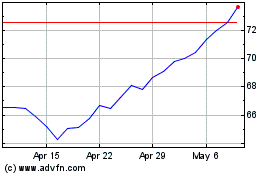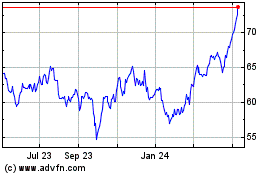POWER POINTS: Demand Drop Delays High-Voltage Line Projects
January 12 2010 - 12:03PM
Dow Jones News
High-voltage power-line projects are becoming the latest victims
of slumping power demand.
Three major transmission projects in the nation's largest power
market face new questions about their need as the economic
downturn, growing power-curtailment programs and electricity
conservation curb demand-growth projections. Two of the projects in
the PJM Interconnection, a 13-state power market in the eastern
U.S., have been put on hold. A third faces additional scrutiny from
regulators.
The opportunities for utilities to boost returns through
transmission projects remain as the U.S. looks to upgrade its aging
electric grid and access growing amounts of wind and other
renewable generation from mostly rural areas. But reliability
projects - built to relieve strains on congested high-voltage lines
- could face growing delays following a two-year slump in
demand.
"There is certainly potential for the projects to be pushed
back," said Paul Flemming, director of power and gas services at
Energy Security Analysis Inc., a Wakefield, Mass., market research
firm.
Possible delays have emerged in recent weeks after PJM provided
a preliminary outlook of updated transmission needs to Virginia
regulators. In response, Allegheny Energy Inc. (AYE) and American
Electric Power Co. Inc. (AEP) withdrew an application in the state
for a $1.8 billion transmission line from West Virginia to
Maryland. The utilities had believed the 275-mile line would be
needed by 2012 or 2013, but it now looks like 2016 is a more likely
date.
The move prompted Pepco Holdings Inc. (POM) to ask Maryland
regulators Friday to suspend a review of a 150-mile, $1.2 billion
transmission line through the state. Approvals for both projects
are on hold until PJM completes a more comprehensive study by early
summer. At the same time, New Jersey regulators are delaying a vote
on the state's section of a nearly $1.3 billion line proposed by
Public Service Enterprise Group Inc. (PEG) and PPL Corp. (PPL) as
they review the recent developments.
Transmission projects are tempting for power companies because
of the favorable returns allowed by federal regulators and the
straightforward nature of their construction. Winning support from
landowners - and the elected officials who represent them -
traditionally has been the major hurdle in developing new
lines.
But in the last two years the recession has sapped power demand
as industrial production slowed and some households cut back.
Although demand is expected to grow this year, U.S. electricity
consumption dropped for two straight years and growth in demand
peaks that often drive infrastructure projects slowed.
In PJM, some states have stepped up conservation programs, while
the number of businesses willing to curtail use at times of peak
demand has grown considerably. Environmental groups point to the
demand-side gains when arguing against the three transmission
projects. They warn the projects could provide a means to bring
cheaper, but emissions-heavy, power generated by coal-fired power
plants in the Midwest and Southeast to markets in the
Northeast.
Utilities say weakened demand likely would cause them to delay
rather than cancel their transmission work, an assessment Flemming
agrees with. Still, the pullback by Pepco on its Maryland project
drew the attention of analysts at Barclays Capital this week. They
issued a note to clients warning the transmission line likely would
be delayed a year or two from its original 2014 in-service
date.
"We are somewhat concerned with this development," they
wrote.
Pepco shares recently were trading at $16.97 apiece, down 2.4%
from a 10-month high reached in mid-December, while Public Service
Enterprise Group shares were down 3.2% from a five-month high
reached in late-December, recently trading at $32.69.
(Mark Peters covers the power and coal industries and
environmental markets for Dow Jones Newswires. He can be reached at
212-416-2457 or by email at mark.peters@dowjones.com.)
(TALK BACK: We invite readers to send us comments on this or
other financial news topics. Please email us at
TalkbackAmericas@dowjones.com. Readers should include their full
names, work or home addresses and telephone numbers for
verification purposes. We reserve the right to edit and publish
your comments along with your name; we reserve the right not to
publish reader comments.)
Public Service Enterprise (NYSE:PEG)
Historical Stock Chart
From Jun 2024 to Jul 2024

Public Service Enterprise (NYSE:PEG)
Historical Stock Chart
From Jul 2023 to Jul 2024
